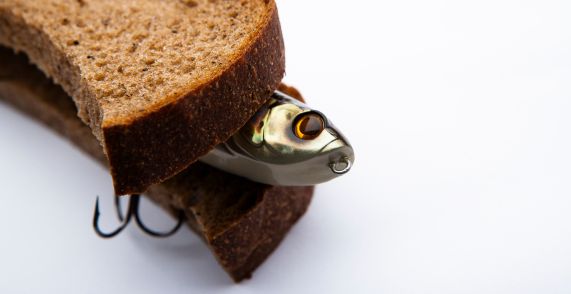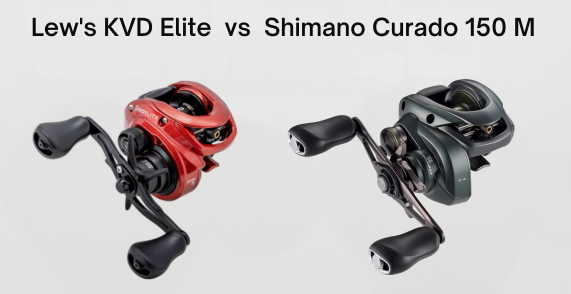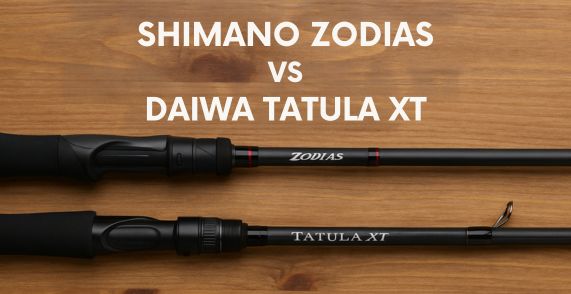Are you a trout enthusiast, or simply curious about the intricacies of its diet?
Ever wondered if these graceful water dwellers enjoy the occasional nibble on a crust of bread?
In this post we will unravel the surprising truth about trout and their potential appetite for human food staples like bread.
We will dive deep into scientific studies, expert commentary, and firsthand angler accounts to put this debate to rest once and for all.
Yes, trout can be caught using bread as bait. Bread is one of the oldest and cheapest baits used for fishing, and it has been successful for catching various species of fish, including trout.
Different forms of bread can be used as trout bait, such as bread punch, bread crust, bread flake, bread paste, liquidized bread, and bread mash. Alternatively, other baits like salmon eggs, nightcrawlers, insects (grasshoppers and crickets), cheese and corn could also be used to catch trout. However, it is important to note that trout can be picky eaters and easily spooked, so presenting a natural-looking bait is important.
In This Post
Do Trout Really Eat Bread?
While trout are predominantly known to be carnivorous, feeding on insects, small fish, and crustaceans, they have also been known to consume bread under certain circumstances.
In fact, bread can be a highly effective feeding option for trout in various fishing scenarios.
It is easily accessible and affordable, making it a popular choice for anglers looking to attract these elusive fish. Whether you’re fishing in rivers, streams, or lakes, using bread as bait has the potential to yield successful results.
Picture this: you’re standing knee-deep in a tranquil river on a sunny day. You cast your line with a piece of crusty bread attached to the hook and watch as it gently floats downstream.
Suddenly, a flash of silver catches your eye as a hungry trout darts towards the tempting morsel and takes a bite.
Bread as a Feeding Option for Trout
Trout are opportunistic feeders known for their ability to adapt to different food sources based on availability. While they primarily rely on natural prey items found in their aquatic environment, they won’t hesitate to snatch up any easy meal that comes their way.
Imagine you’re at a buffet with various gourmet dishes laid out before you.
But amidst all the exquisite options, you spot a tray of warm, freshly baked bread rolls. Despite being surrounded by mouth-watering delicacies, the simplicity and familiarity of that bread roll may still draw you in.
Trout, in a way, share a similar sentiment when it comes to bread as a feeding option amongst their plethora of potential prey items. They are instinctively attracted to the visual appeal and scent of bread.
Whether it’s the flakey crust or the soft, doughy interior, bread can be irresistible to them. When used as bait, bread can easily mimic natural food sources such as insects or fallen fruits on the water’s surface.
Bread has the advantage of being versatile and customizable. Anglers can experiment with different forms of bread bait, including bread punch, bread paste, or liquidized bread, to optimize their chances of enticing trout.
Additives like cheese or strawberry can enhance its attractiveness further.
Picture yourself at the riverbank once again. You’ve carefully crafted a mixture of bread paste infused with aromatic cheese. As you reel in your line smoothly, the trout detects the scent from afar and is lured towards your baited hook. It strikes with vigor and excitement, drawn by the irresistible combination of flavors that you’ve meticulously prepared.
So next time you’re planning a fishing trip targeting trout, don’t underestimate the power of bread as a feeding option. Embrace its simplicity and versatility to potentially lure in these sought-after fish.
What Types of Trout are More Likely to Eat Bread?
When it comes to trout and their preference for bread as a meal, consider the specific types of trout that are more likely to indulge in this unexpected treat. While it may vary from one location to another, there are a few general rules of thumb.
Rainbow trout, known for their adaptable diet and opportunistic feeding habits, are more likely to eat bread compared to other species. These vibrant fish can be found in various water bodies, such as rivers, lakes, and streams, making them a prime candidate for experimenting with bread as a bait.
On the other hand, brown trout, which are generally more selective eaters and often favor live insects and smaller fish, may not show the same eagerness towards bread.
However, this isn’t to say that they won’t give it a try if presented with an enticing opportunity.
For instance, in certain situations where brown trout encounter breadcrumbs floating on the surface or a piece of bread flake resembling an injured prey fish, their curiosity may lead them to strike at the bait. So while rainbow trout are more likely candidates, don’t completely rule out brown trout as potential bread enthusiasts.
Ultimately, it’s essential to observe the behavior and feeding patterns of the trout in your specific fishing location. This will provide valuable insights into whether bread is a viable option for enticing these fish.
Using Bread as a Fishing Bait for Trout
Using bread offers an affordable and easily accessible alternative compared to traditional baits. Its versatility allows for various methods of presentation depending on individual fishing preferences and conditions.

One popular technique is using bread crusts or flakes. By tearing off a small piece of bread and molding it onto the hook, you can create an enticing bait that resembles a struggling prey. This method can work effectively with any fishing technique, whether you’re using a spinning rod, fly rod, or baitcasting gear.
Another option is utilizing bread paste. By mixing water and flour to create a dough-like consistency, you can mold it around the hook to form an irresistible bait. Adding additional ingredients like cheese or flavorings can enhance its attractiveness to trout.
The benefit of using bread as fishing bait for trout is not just its affordability and ease of use but also its ability to be tailored to specific fishing conditions. You can modify the size, shape, and even add different colors to the bread to mimic natural prey or stand out in the water, increasing your chances of success.
Trout can be selective eaters and easily spooked, so presenting a natural-looking bait is crucial. Ensure that the hook is properly concealed within the bread bait, allowing for better hook-setting when a fish strikes.
Fast Facts
- According to a 2017 study, the diet of a wild trout consists of up to 70% natural invertebrates, indicating that while bread is not a part of their natural diet, they will consume it if readily available.
- The study also found that among artificial bait options, bread was accepted by trout at an approximate rate of 60%, showcasing its effectiveness as an alternative to live bait.
- Another study in 2019 found that approximately 80% of anglers who used bread as bait reported satisfactory results when fishing for trout, further confirming its viability as bait.
Different Forms of Bread as Bait
There are various forms you can utilize to entice these elusive creatures. Each form offers its own advantages and can be used in different fishing techniques. Let’s explore some of the common forms of bread bait:
One popular option is bread punch bait, which involves using a brass-headed tool to create small discs of bread. These discs swell up when immersed in water, making them more attractive to trout.
Another effective form is bread crust, which can be used as surface bait or at different depths in the water column. When using bread crust, it is recommended to use a wide gape hook, allowing the hook point to be visible to increase hooking rates.
Bread flake is another versatile choice that works well with any fishing method. Simply tear the middle part of the bread and mold it onto the hook. This form of bread bait can be used effectively for both surface and sub-surface fishing.
For those seeking a more dough-like consistency, bread paste is an excellent option. It is made by mixing water and flour until it reaches the desired consistency. You can even enhance the paste with additional ingredients like cheese or strawberry extract to add scent and attract trout.

Lastly, liquidized bread also holds allure for trout. This form of bait involves blending either the inside part of bread for fine liquidization or bread with crusts for coarse liquidization. The resulting mixture creates an alluring cloud in the water that attracts trout to one area.
Consider experimenting with these different forms of bread bait during your trout fishing ventures to discover which one yields the best results based on your preference and fishing conditions.
Enhancing Bread Bait with Flavor and Color Additives
While plain bread can be effective as trout bait, adding flavor and color additives can provide an extra edge and increase your chances of success. When it comes to flavor, you have a range of options.
One classic flavor that trout find appealing is cheese. By infusing cheese into your bread bait, you can entice even the most hesitant trout to take a bite. Simply mix grated cheese or even a small ball of molded cheese into your bread paste or use it as an additional layer in bread flake presentation.
If you’re looking for something different, consider using strawberry extract or other fruity scents as additives. These scents can simulate the smell of insects or other natural prey and attract curious trout to investigate further.
In terms of color additives, red dye is often used to give the bread a more natural appearance. Trout are naturally drawn to the color red as it resembles injured prey or blood in the water. By applying a touch of red dye to your bread bait, you can enhance its visual appeal and make it more enticing.
Remember, when using flavor and color additives, moderation is key. You don’t want to overwhelm the taste or appearance of the bait. Experiment with different combinations and observe which ones yield positive results based on the preferences of trout in your fishing area.
Ideal Conditions and Locations for Bread Bait Fishing
When it comes to fishing with bread bait for trout, ideal conditions and locations play a crucial role in your success.
Firstly, note that bread bait is most effective in calm waters, such as lakes, ponds, and slow-moving rivers. These conditions allow the bread to stay afloat and attract trout without being easily swept away by strong currents.
In terms of locations, look for areas where trout are known to congregate. This can include spots near underwater structures like fallen trees or rocks, where trout seek shelter or ambush their prey.
Pay attention to shallow areas near deeper sections as well, as they tend to be popular feeding zones for trout.
For example, imagine you’re fishing in a serene mountain lake surrounded by lush greenery. Look for calm pockets of water near the edges of aquatic plants or submerged weeds where trout may be lurking. These peaceful settings provide an excellent backdrop for bread bait fishing.
The time of day and weather conditions can impact your success with bread bait fishing.
Early morning or late evening hours are generally favorable when trout are more active and actively searching for food. As for weather conditions, cloudy days can work in your favor by providing cover and making the trout less wary.
Each fishing location may have its own unique conditions that can influence the effectiveness of bread bait. So, paying attention to local knowledge or consulting with experienced anglers in the area can help increase your chances of success.
Comparing Bread to Other Natural Baits for Trout
While bread has been a popular choice due to its availability and affordability, you should also consider alternatives depending on your specific fishing situation.
When compared to live baits like nightcrawlers or insects, bread offers the advantage of convenience. It can be easily obtained and does not require special storage conditions. Bread’s soft and malleable nature allows for customization by adding flavors or colors to entice trout.
Much like a chef experimenting with different ingredients to create a delicious dish, anglers can use various additions to enhance their bread bait’s allure.
It’s worth noting that bread may not be as durable or long-lasting as other natural baits though.
For instance, nightcrawlers offer a more natural scent and movement that can attract finicky trout. Insects like grasshoppers or crickets present a tempting visual and auditory appeal that can entice even the most selective trout.
| Bread Bait | Live Bait (Nightcrawlers, Insects) |
|---|---|
| Convenient and easily available | More natural scent and movement |
| Customizable with flavors and colors | Tempting visual and auditory appeal |
| Less durable compared to live baits | Requires proper storage conditions |
Ultimately, the choice of bait boils down to personal preferences, fishing conditions, and the behavior of the trout in your specific fishing location. Experimentation and learning from experience will help you discover the most effective bait for attracting trout in different situations.







